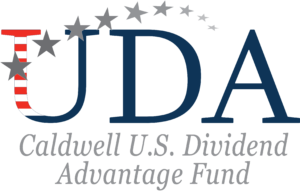For the month of December, the Caldwell U.S. Dividend Advantage Fund (“UDA”) gained 3.5%1 versus 2.9% for the S&P 500 Total Return Index (“Index”). Consumer Staples, Real Estate, Utilities and Healthcare were top performing sectors. From a security selection standpoint, the Fund’s holdings in Consumer Staples and Healthcare outperformed their respective sector benchmark. Despite rising oil prices, Energy recorded its second consecutive month of weak performance. Communications Services and Consumer Discretionary stocks were also relative underperformers. However, similar to Consumer Staples and Healthcare, the Fund’s Consumer Discretionary holdings outperformed the sector benchmark.
For the full year, Energy, Real Estate and Financials were top performers. These sectors were most adversely impacted by lockdowns in 2020 and conversely saw strong recoveries as the economy reopened. Utilities, Consumer Staples and Industrials were relative underperformers. However, it’s important to put relative underperformance in context as every sector in the Index recorded double digit gains for the year.
Top contributors to UDA performance in December were Broadcom (“AVGO” +19.1%; full year +54%), UnitedHealth Group (“UNH” +11.6%; full year +44%) and Murphy USA (“MUSA” +13.2%; full year +51%)2. AVGO held a top performing spot for the second consecutive month following a solid earnings report and robust demand outlook across nearly all of its end markets. The company also announced a new $10 billion share buyback program and a 14% increase in the dividend. UNH rose following a positive outlook detailed in its annual investor day. Management also noted the commercial insurance pricing environment is rational and overall utilization is trending near pre-COVID levels (with minimal signs of a pent up procedure backlog) which helped alleviate concerns about near term earnings headwinds. MUSA announced a new $1 billion share buyback program and fuel margins were solid for the industry in the fourth quarter as retail fuel demand continues to bounce back to pre-COVID levels. Industry data also suggests retail fuel demand held strong despite the Omicron wave and one could argue that cancelled domestic flights could have boosted demand for ground-based travel during the holiday season.
During December, the Fund added a position in Installed Building Products (“IBP”).
IBP is a leading installer of insulation and other building products in residential and commercial new construction markets across the U.S. A fragmented market provides ample opportunity for scale players such as IBP to grow by acquisition while leveraging its buying power to drive cost synergies. A record backlog of new homes under construction provides solid demand in the near to medium term. Lastly, IBP generally benefits from inflationary environments given its strong pricing power. With material manufacturers set to increase prices in 2022, IBP has the potential to leverage that and its lower cost structure to drive stronger profitability than its smaller peers.
Rising rates and inflation continue to dominate the market narrative, especially since the former poses a risk to higher multiple stocks that currently have an outsized weighting in major market benchmarks. However we remain constructive heading into 2022 and believe the UDA, with its unique momentum-driven investment approach and focus on well-managed, dividend growth companies, is well positioned to provide strong performance in environments such as these. We expect that dividend growth investing, which has been foundational to the Fund’s investment approach, will continue to provide a means of generating attractive risk-adjusted returns for our investors over the long term.
1Standard performance as at December 31, 2021:
Caldwell U.S. Dividend Advantage Fund Series F: 1 Year: 22.51%, 3 year: 17.09%, 5 year: 11.34%, Since Inception (June 19, 2015): 10.83%.
S&P500 Total Return Index: 1 Year: 27.61%, 3 year: 22.83%, 5 year: 17.06%, Since Inception (June 19, 2015): 15.98%.
2Actual investments, first purchased: AVGO 11/1/2018, UNH 10/23/2018 and MUSA 10/14/2021.
All data is as of December 31, 2021 sourced from Morningstar Direct or S&P Capital IQ,, unless otherwise indicated. Fund returns are from FundData. UDA, Index total return numbers, sector returns and individual stocks returns are in CAD terms. The Fund was first offered to the public as a closed-end investment since May 28, 2015. Effective November 15, 2018 the Fund was converted into an open-end mutual fund such that all units held were redesignated as Series F units. Performance prior to the conversion date would have differed had the Fund been subject to the same investment restrictions and practices of the current open-end mutual fund.
The information contained herein provides general information about the Fund at a point in time. Investors are strongly encouraged to consult with a financial advisor and review the Simplified Prospectus and Fund Facts documents carefully prior to making investment decisions about the Fund. Commissions, trailing commissions, management fees and expenses all may be associated with mutual fund investments. Rates of returns, unless otherwise indicated, are the historical annual compounded returns including changes in unit value and reinvestment of all distributions and do not take into account sales, redemption, distribution or optional charges or income taxes payable by any unitholder that would have reduced returns. Mutual funds are not guaranteed; their values change frequently and past performance may not be repeated. The payment of distributions should not be confused with a fund’s performance, rate of return or yield. If distributions paid are greater than the performance of the fund, your original investment will shrink. Distributions paid as a result of capital gains realized by a fund, and income and dividends earned by a fund, are taxable in your hands in the year they are paid. Your adjusted cost base (“ACB”) will be reduced by the amount of any returns of capital and should your ACB fall below zero, you will have to pay capital gains tax on the amount below zero.
Publication date: January 19, 2022.
